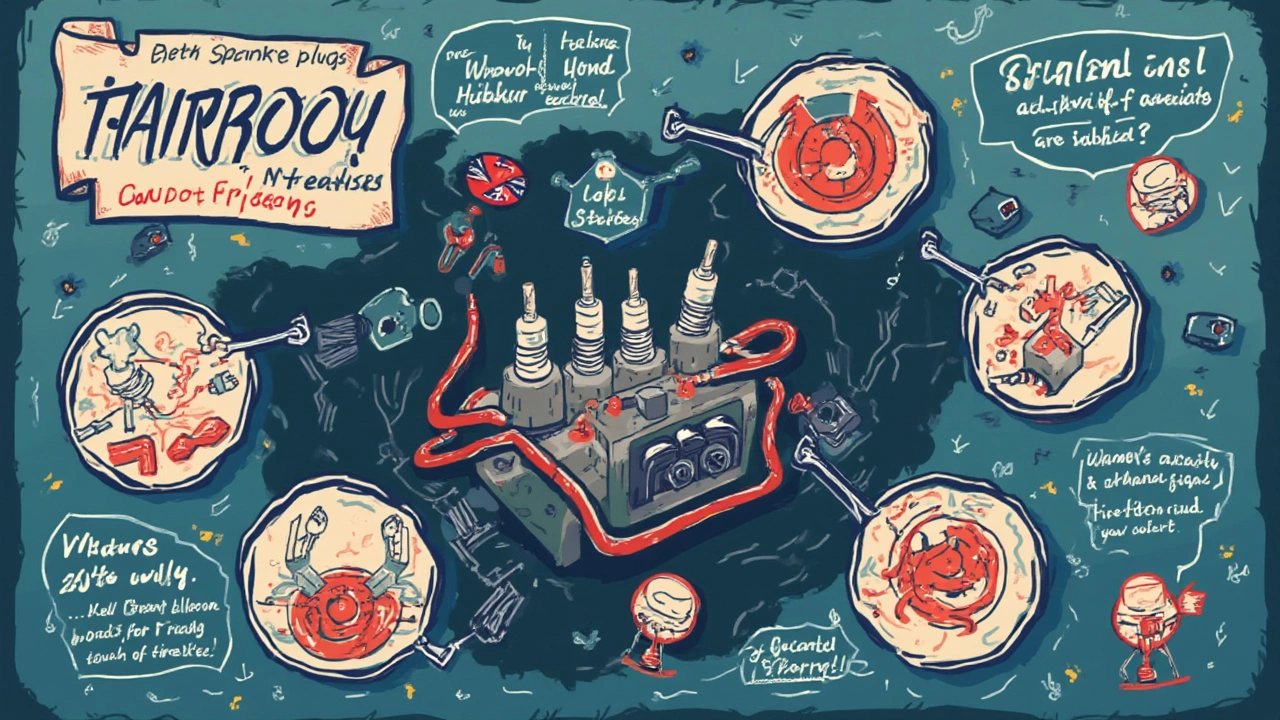Your car’s spark plugs are tiny, but they’ve got a huge job. They fire up the fuel in your engine, making sure your ride starts and runs smooth. But when spark plugs start going bad, the whole system goes off balance. You might press the gas and feel the car stutter or jerk. Ever notice your engine sounding rough or shaking when you stop at a light? Yep, old or failing spark plugs could be to blame.
If you keep driving with junky spark plugs, it’s not just annoying. You’ll end up burning more fuel, which means more cash every time you fill up. Over time, bad plugs can also clog up your catalytic converter—which is way more expensive to fix. It doesn’t stop there. Your engine might struggle with power, especially when you try to accelerate or drive uphill.
So, what should you watch for? Hard starts, sluggish acceleration, and weird engine noises are the big red flags. Got a check engine light? Don’t ignore it. Swapping out spark plugs is a lot cheaper than repairing serious engine damage down the road.
- Why Spark Plugs Matter
- Early Signs of Trouble
- How Bad Spark Plugs Mess With Your Drive
- Costs and Risks of Ignoring the Problem
- Checking and Changing Spark Plugs
- Simple Tips for Keeping Your Engine Happy
Why Spark Plugs Matter
If your car had a heartbeat, the spark plug would be right at the center of it. When you turn the key, these little guys send a jolt of electricity that lights up the fuel-air mix inside your engine. Without a good spark, your engine can’t start, let alone run the way it’s supposed to.
Every cylinder in your engine needs its own spark plug, and they all fire off several times per second. That’s what keeps the engine humming. If even one plug goes bad, the whole system gets thrown out of sync. Suddenly, you’re burning more fuel, getting less power, and feeling every bump and hesitation on the road. That’s why fixing bad spark plugs isn’t just a suggestion—it’s basic car care.
| Spark Plug Job | What Happens If It Fails? |
|---|---|
| Ignites fuel/air mix | Poor or no combustion—car hesitates or stalls |
| Keeps engine running smooth | Engine shakes or vibrates at idle |
| Boosts fuel efficiency | Wasted gas, more stops at the pump |
Here’s a wild fact: A healthy spark plug creates tiny explosions in your engine up to 25,000 times per minute when you’re cruising down the highway. That’s non-stop work all drive long. Most spark plugs last around 30,000 to 100,000 miles, depending on what they’re made of and your driving habits. Regular wear just can’t be avoided, so swapping them out before they fail is a move that saves a ton of headaches.
Bottom line—spark plugs are cheap, but the trouble they prevent is priceless. For just a little maintenance, you’ll dodge lots of frustration and avoid spending big bucks later on bigger repairs.
Early Signs of Trouble
Catching bad spark plugs early can save you from bigger problems later. The most common clues show up when you least expect them – usually on a busy morning or right before a road trip. Ignoring the warning signs won’t make them disappear. Here’s what you might notice when your spark plugs start to fail:
- Rough idling: If your engine starts to feel bumpy or shaky when you’re stopped, your spark plugs might not be firing right.
- Difficulty starting your car: You turn the key and instead of a quick start, the engine cranks forever or doesn’t start at all.
- Poor acceleration: Pressing the gas pedal should give you a smooth boost. If your car feels slow to respond, it could be a spark issue.
- Weird engine noises: Pops, clicks, or knocking sounds while driving aren’t normal. Bad spark plugs can cause that extra racket under the hood.
- More trips to the gas station: When plugs are worn out, they burn fuel less efficiently, meaning you’ll notice worse mileage.
- Check engine light: One of the most ignored but useful alerts. A flashing or steady light can often mean misfiring spark plugs or related issues.
Here’s a quick table showing how common these symptoms are when spark plugs start going bad:
| Symptom | How Often It Happens (%) |
|---|---|
| Rough idling | 65% |
| Hard starting | 54% |
| Poor acceleration | 47% |
| Noisy engine | 40% |
| Bad fuel economy | 58% |
| Check engine light | 67% |
It’s pretty clear—these issues don’t just go away with time. Pay attention to them, especially since bad spark plugs are such a common problem and usually easy to replace. If you spot more than one of these signs—don’t wait until your car leaves you stranded.
How Bad Spark Plugs Mess With Your Drive
Running your car with bad spark plugs throws off how your engine works. The spark plugs are supposed to set off the fuel-air mix at just the right time. When they’re shot, the timing gets weird, so your engine can start misfiring or even stall out completely. If you’re sitting at a stop sign and feel a shake or hear a popping noise from under the hood, that’s probably a misfire caused by failing plugs.
The main thing you’ll notice is a loss of power. Step on the gas and your car might stutter, lag, or just not pick up speed like it should. This matters most when you need power quickly, like when merging onto a highway or passing someone. Your engine basically feels "lazy" because bad spark plugs don’t always give a strong enough spark.
Your mileage will take a nosedive too. According to AAA, faulty plugs can drop your fuel efficiency by up to 30%. That means more of your money disappears with every trip to the pump. On top of that, rough idling, hard starts, and increased emissions all make everyday driving more of a headache.
Check out how these issues stack up when you ignore bad spark plugs:
| Problem | Common Effect | Potential Cost |
|---|---|---|
| Hard Starting | Engine cranks but doesn't fire up quickly | Extra battery strain, possible jump-start needs |
| Engine Misfire | Jerking, loss of power, loud pops | Rough ride, possible catalytic converter damage ($1,000+) |
| Reduced Fuel Economy | Worse gas mileage, more fill-ups | Lost cash at the pump, up to $300 extra/year |
| Increased Emissions | Higher pollution, may fail inspection | Fines or failed state inspection |
Long story short: neglect bad spark plugs and your car turns into a moody, fuel-chugging, noisy headache. Spending a bit now to fix them can keep your engine—and your wallet—happier for the long haul.

Costs and Risks of Ignoring the Problem
Ignoring bad spark plugs isn't just a minor annoyance; it actually chips away at both your wallet and your car’s health. Let’s break down exactly what’s at stake if you keep pushing a car with bad plugs.
- Lower Fuel Economy: When your spark plugs don’t fire right, your engine works harder and uses more fuel to get the same job done. That means you’re filling up at the pump more often, and those extra costs add up quick.
- Engine Damage: Misfires caused by faulty plugs stress out your engine’s parts. Over time, you’re looking at possible piston or cylinder head damage—and these repairs jump into the four-figure range fast.
- Catalytic Converter Trouble: Unburned fuel from misfires can overheat your catalytic converter (the thing that cleans up your exhaust). Replace one, and you’re looking at $900 or more, sometimes double that, depending on your ride.
- Starting Issues: Your car might struggle to start, especially when it’s cold. In the worst cases, it might not start at all, leaving you stranded.
- Emissions Fails: More misfires mean more unburned fuel, so you’re way more likely to fail emissions tests. Then you’ll have to fork out for repairs and a retest.
Here’s a quick look at the real-world costs you could face if you keep driving with bad plugs:
| Problem | Average Repair Cost (USD) |
|---|---|
| Spark Plug Replacement (set of 4) | $60 - $200 |
| Catalytic Converter Replacement | $900 - $2,500 |
| Piston/Cylinder Damage | $1,000 - $4,000 |
| Failed Emissions Test | $25 - $100 (plus repairs) |
Think about it: changing a set of spark plugs is a lot cheaper than major engine repairs. If you’re hearing weird noises, struggling to start, or spending more at the pump, deal with those plugs before your costs spiral out of control.
Checking and Changing Spark Plugs
So, you suspect your spark plugs might be worn out. It’s actually pretty simple to check them yourself. Most cars make it easy—just pop the hood and look for the thick wires running down into the engine. Each wire leads to a spark plug. Always wait for a cold engine if you plan to touch anything.
The first step is to pull the wire or ignition coil off. Use a socket wrench with a spark plug socket (these are easy to find at any auto store). Give it a gentle twist and pull out the plug. Now take a look: does it look black, oily, or just plain crusty? That’s a sign of trouble. Healthy plugs have a light tan or gray tip. Anything else means they’re not doing their job.
If you spot a problem, swapping them out isn’t hard. Just buy replacements that match your car model—your owner’s manual or even a quick online search will tell you the right part number. Don’t be tempted to grab the cheapest option, though. Good plugs last longer and save you headaches later.
- First, take out the old spark plug like you did before.
- Check the gap on the new one with a gap gauge—most plugs are set at the factory, but it’s better to double-check.
- Carefully screw in the new plug by hand first, to avoid cross-threading.
- Tighten it snug, but don’t overdo it. A quick twist with the wrench is plenty.
- Pop the wire or coil back on, and you’re done.
One more thing—change all the plugs at the same time, not just one. If one goes bad, the others aren’t far behind. Most modern cars go 60,000 to 100,000 miles before you need to think about this job, but if you notice weird engine issues, don’t wait. Staying on top of your bad spark plugs now means fewer breakdowns and better fuel mileage later.
Simple Tips for Keeping Your Engine Happy
Keeping your engine in top shape really isn’t complicated, and you don’t have to be a car expert to make a big difference. A lot of car trouble comes from skipping basic stuff, like checking up on your bad spark plugs before they start causing headaches. Here are some real-world ways to keep things running smooth and avoid big repair bills:
- Stick to the maintenance schedule. Every car manual comes with a service schedule for things like spark plugs. Most modern cars need new plugs every 30,000 to 100,000 miles. Always check what the manufacturer recommends for your ride.
- Don’t ignore warning signs. If your car starts misfiring, shakes at idle, or loses zip when you floor it, get those plugs checked. The sooner, the better.
- Use the right plugs for your car. Different engines need different plugs—copper, platinum, or iridium. Putting in the wrong type can mess with performance and hurt your fuel efficiency.
- Get regular tune-ups. When you get your car serviced, ask the mechanic to check the spark plugs (and wires if you’ve got an older model). Catching a bad plug early is way cheaper than fixing a bigger mess later.
- Watch your fuel economy. If you notice you’re filling up more often, don’t just blame it on gas prices. Bad spark plugs are known to drop fuel efficiency by up to 30%.
If you want to see how much poor upkeep can cost, check out this quick table with real numbers:
| Neglected Maintenance | Resulting Repair | Estimated Cost |
|---|---|---|
| Bad Spark Plug Ignored | Engine Misfire Repair | $200–$700 |
| Old Plugs Damage Converter | Catalytic Converter Replacement | $900–$2,500 |
| Poor Fuel Burn Over Time | Loss in MPG (every fill-up) | Up to 30% more on gas |
Staying alert and swapping out plugs before they go bad is the easiest way to dodge these hits to your wallet. Pick a day to check under the hood and stick to it every year, even if your car seems fine. A little effort now pays off big later on.

